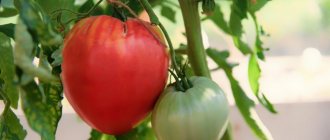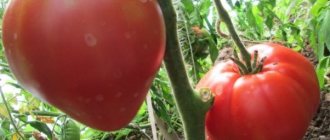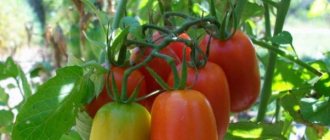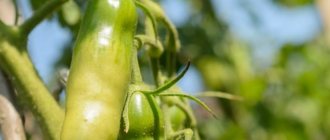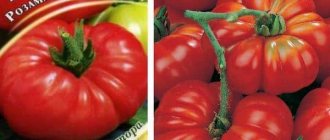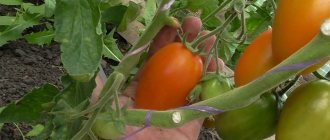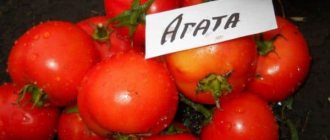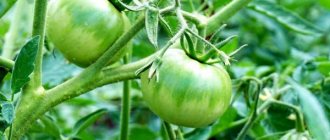The Katya tomato has not been known for long, but has already gained fame as one of the best among the super early salad varieties. It ripens earlier than most other tomatoes, produces a solid harvest of smooth, beautiful fruits of excellent taste, grows as a small bush, and is easy to care for. Those who have tested this variety in their garden agree that it can be recommended to anyone, even the most inexperienced summer resident.
- 1.1 Region and growing conditions
1.1.1 Video: tomato Katya in the greenhouse
- 2 Advantages and disadvantages, features
2.1 Differences from other varieties
- 3.1 Landing
3.2.1 Video: formation of determinate tomato bushes
Description and characteristics of "Katya"
"Katya F1" is a universal tomato. The hybrid has excellent varietal characteristics and is actively grown under film, in polycarbonate greenhouses, and simply in open ground.
Region and growing conditions
Recommended growing region is North Caucasus. In fact, the “Katya” tomato is grown by gardeners from various regions of the Russian Federation, as it grows excellently both in open ground and in greenhouse conditions.
How to properly grow tomatoes in open ground, read here.
Description of the variety
Brief botanical description:
- Bush. Height -60 cm. Determinate - limited in growth. The foliage is weak - there is no need to thin out the green mass often.
- Flowers and fruits. The inflorescences are simple, with 7 to 15 ovaries in the raceme. The first inflorescence is formed above the 5th leaf. Fruit weight - 80-120 g. Tomatoes are the same size, flat-round, not ribbed, slightly flattened. There are few seeds inside the fruit - one seed nest contains only three seeds. The color when ripe is uniform, at first light green, which gradually turns into bright red. There are no stains or inclusions.
“Kati” fruits have a dry matter content of 4.6% and sugar content of 2.9%.
Varietal characteristics
"Katya" refers to early ripening, ultra-early hybrids. To get fresh tomatoes early, even in the southern regions they use seedlings.
Varietal characteristics of the hybrid "Katya":
- The fruits ripen together. From the moment of germination to the appearance of the first ripe tomatoes, 75-80 days pass.
- Resistant to high humidity and drought.
- Resistance to diseases - blossom end rot, tobacco mosaic virus, late blight, alternaria.
- 85-95% of the fruits have an excellent presentation.
- Well transported.
- The taste is pleasant, with sweetish notes. Slight sourness, sugary pulp.
“Katya” tomatoes are hybrids, so seeds taken from grown tomatoes do not repeat the parental characteristics. Seed material must be purchased annually.
Purpose of fruits
“Katya” is valued for its versatility. The excellent taste of the hybrid is combined with its suitability for a variety of preparations. These tomatoes are delicious fresh, they can be eaten whole, in the form of salads, dried, juiced, pastes and sauces. Tomatoes are suitable for whole-fruit canning.
Watch a video review of the hybrid tomato “Katya”:
Productivity
Productivity of tomato "Katya F1":
- in open ground - 8-10 kg per 1 sq. m;
- in a greenhouse - 12-15 kg per 1 sq. m.
This yield is considered quite high for an early variety. A good harvest is convenient when growing crops for sale. For comparison, Table 1 shows the yields of other popular tomato varieties. The indicated values are for open ground.
Table 1
| Variety | Productivity, kg per 1 sq. m |
| King of the market | 10-12 |
| The president | 7-9 |
| Lazy | 13-15 |
| Summer resident | 4-5 |
| Doll | 8-9 |
| Lady Shady | 7-8 |
| Fat Jack | 5-6 |
| Gulliver | 6-8 |
Transportability
“Katya” fruits have a high density, they are easily transported, do not leak or squash. During transportation they do not crack and do not lose their presentation.
If tomatoes are picked for sale and are to be transported, it is better to take them in a state of blanche ripeness. After a few days, while the tomatoes are in transit, they will become marketable.
Description of the hybrid
The Katya variety is determinate, tall, grows up to half a meter. When grown in a greenhouse it is slightly higher, approximately 1m 30 cm. The plant has many dark green leaves.
As a rule, tomatoes are formed into 1, 2 or 3 stems. During the growing season, the bushes must be tied up and stepsoned.
The inflorescences on a tomato are simple, several of them are formed. The first flower raceme is formed above the 5th or 6th true leaf. As a rule, from 5 to 8 fruits are tied on each cluster. The weight of each of them reaches 100-130 grams.
The fruits are medium-sized, round, slightly flattened, dense, elastic with juicy pulp. At technical ripeness, Katya F1 tomatoes are red in color, the coloring is uniform over the entire surface, without a green spot at the stalk.
The fruits are tasty, sugary with a barely noticeable sourness, and do not crack during ripening. Sugar content is about 2.9%, and dry matter is 4.8%.
The variety is considered ultra-early, since the first ripe fruits can be harvested 80 days after sowing the seeds.
Advantages and disadvantages of the variety
The secret of the popularity of “Katya” is the combination of two varietal characteristics, which are of decisive importance for gardeners and summer residents. These tomatoes are tasty, productive and easy to care for. But these are far from the only advantages of the hybrid.
Pros:
- high precocity;
- friendly ripening of fruits;
- undemanding to the composition of the soil;
- high taste and commercial qualities of fruits;
- high yields;
- resistance to diseases characteristic of nightshades;
- resistance to temperature changes and drought - can withstand several days without watering without damaging the crop;
- simple agricultural technology - do not require tying or pinching;
- good keeping quality - fruits picked brown are ripened efficiently without losing their taste;
- versatility of fruit use.
Many of the benefits of "Katya" are easily explained by its botanical characteristics. For example, high yields and excellent fruit characteristics are associated with the low foliage of the bush - it spends most of its energy on ripening tomatoes.
Minuses:
- due to the severity of the fruits, branches may break;
- in rainy weather, plants can be affected by phomosis and mosaic;
- demanding feeding - lack of nutrition causes a drop in yield.
Variety varieties
The hybrid "Katya" has a variety that differs only in one quality - color. It is not difficult to guess that “Pink Katya” has fruits that are not red, but pink.
All other characteristics of the hybrids are the same - bush height, early ripening, transportability, etc. But in terms of productivity, the pink analogue even surpasses the red “Katya”; in greenhouses it reaches 18 kg per 1 sq. m.
Pink Katya
Differences from other varieties
Comparing “Katya” and its pink variety with early varieties of tomatoes, it is easy to notice:
- Their sugar content is lower than that of "Bull's Heart".
- Ripens earlier than many early varieties. For example, he is 2 weeks ahead of “Lyan”.
- The Mongolian Dwarf is superior in taste.
- The productivity of “Yablonka Rossii” and “Siberian early ripening” is twice as high.
- Significantly superior to “Classic White” in disease resistance.
- It is transported better than "Betta" and many other varieties.
Features of growing seedlings of the “Katya” variety
Tomato "Katya" can be sown with seeds, but growing by seedlings is considered more effective. Without seedlings, the early maturity of the hybrid will not bring much benefit. The peculiarity of the hybrid is an early harvest, and only seedlings allow you to take full advantage of this advantage.
Soil requirements
Optimal soils are sandy and loamy. High breathability is welcome. Seeds for seedlings are sown in soil covered with film or in containers filled with soil mixture. The latter can be purchased in agricultural stores - there are mixtures specifically for tomato seedlings.
If seeds are sown in the soil, it must be properly prepared. To find out your soil type, simply wet and knead a handful of soil in your hand. If a tube rolled between the palms cracks when bent, the soil is loamy; if it does not crack, it is clayey.
Any of the soils must be fertilized - this is the only way to count on high yields and good taste of tomatoes.
Fertilizing open ground depends on the type of soil:
- Sour. Once every 3-4 years, add dolomite flour or lime - 300-600 g per 1 square meter. m.
- Heavy clayey. For 1 sq. m, add 2 buckets of rotted manure. Compost will work instead of manure. A bucket of sand will be useful - it is soaked in advance with a urea solution (150 g per bucket of water).
Timing for planting seeds
When sowing seeds, it is necessary to take into account that the seedlings will be ready in about 2 months. By this time, if planting in open ground, the weather should be warm outside. Each region has its own landing dates. So, in the North Caucasus region, sowing of seedlings begins in winter - in February, and before May Day the seedlings are ready for planting.
In the middle zone, planting in the ground is risky before the beginning of summer, so for open ground seedlings are sown at the end of March. Planting will take place in early June, and by early July it will be possible to pick the first tomatoes.
Approximately 100 days pass from the emergence of seedlings to the harvesting of fruits. Based on this figure, the timing of sowing, planting seedlings and harvesting is calculated.
Seed preparation
Hybrid seeds are prepared for sowing as standard - they go through all stages of preparation aimed at increasing germination, including:
- Calibrate - select suitable specimens.
- Disinfect in a solution of potassium permanganate.
- Wash after disinfection and soak.
- They are hardened before sowing at a temperature of 0-3 degrees for 16 hours. To do this, the seeds are placed on the top shelf of the refrigerator.
When sprouting, it is important not to overcook the seeds - the sprouts should not turn into long thin threads. Read more about germinating tomato seeds here.
Sowing tomatoes for seedlings
You can use any containers, boxes, boxes for seedlings. But it is best to use special seedling containers. There are holes at the bottom through which excess moisture is drained. If they are not provided for, the seedlings will become infected with blackleg. Instead of a store-bought substrate, you can use a peat-sand mixture - the ingredients are taken in equal parts.
Sowing order:
- The substrate or soil mixture is watered abundantly.
- Before sowing, seeds are heated for 2 days at +30 °C, then for 3 days at +50 °C.
- The seeds are buried 1-2 cm. An interval of 2-3 cm is maintained between adjacent seeds. You cannot sow tomatoes densely - the seedlings will grow weak, thin, and non-viable.
- The crops are covered with film or glass.
How to care for seedlings?
Features of caring for seedlings:
- From the moment of sowing until germination, the temperature is maintained at +22-25 °C.
- As soon as the sprouts appear, the film is removed so that the seedlings do not suffocate in the fumes.
- The temperature is lowered to 18 °C, then raised again to 20-24 °C.
- Seedlings are provided with sufficient lighting. It is usually placed on the windowsill.
- Water the seedlings as needed using a spray bottle. Plants cannot be overwatered.
Picking seedlings
After 10-12 days, when the seedlings have 2-3 true leaves, they are planted in separate containers. If this is not done, the seedlings will become excessively elongated.
Picking features:
- Picked plants are buried in the soil to the level of cotyledon leaves.
- Seedlings are watered rarely and moderately. The water is only warm.
- Feed 1-2 times with mineral complex fertilizers or a solution of wood ash.
- If the seedlings begin to stretch, turn on additional lighting.
- A week before planting the seedlings in the ground, hardening begins - they are periodically taken outside for a short time.
“Kati” seedlings, with proper agricultural technology, grow strong and stocky. It is never too long. The usual height of seedlings ready for planting is 15-20 cm.
Find more information about picking tomato seedlings here.
Planting and propagation
Starting from the second ten days of March, they begin sowing. The seeds are first placed for several hours in a weak solution of potassium permanganate , then laid out on a damp cloth to swell.
With the appearance of root rudiments, the prepared material should be sown in a box filled with purchased soil or a mixture of garden soil and sand.
Before sowing, the soil is spilled with boiling water or calcined in the oven to destroy overwintering pest larvae.
The soil in the box is compacted, shallow grooves are made with a ruler, the seeds are laid out using tweezers, and sprinkled with soil. Gently sprinkle with boiled water, wrap in polyethylene, and place in a warm place until germination. As soon as the sprouts begin to emerge, the shelter is removed and the boxes are moved closer to the sun.
To prevent Katya tomato plants from stretching out, care should be taken to pick them in a timely manner. Before transplanting, water the seedling boxes, take out the plants along with a lump of earth, and try to shorten the root system by a third.
Dive one plant at a time into a separate container, deepen it to the lower leaves when planting. Slightly compact the soil near the root collar, water with settled water, and provide protection from direct sunlight.
Before planting in open ground conditions, it is necessary to harden the seedlings so that they do not die from temperature changes. They take the plants outside first for a few hours, then leave them for the whole day. As soon as the tomatoes' stems get stronger and change color from greenish to bluish, it's time to start planting in the garden.
Attention! Weak seedlings with thin stems will die after a couple of days if they are not provided with additional film cover. When planting, maintain a distance of 50 cm between plants.
Planting seedlings in open ground
The easiest and least expensive way to grow tomatoes is to plant seedlings in open ground. There is no need to spend money on film, you don’t need a greenhouse - the seedlings are planted in the open air.
Timing for planting seedlings of the “Katya” variety in open ground
Planting seedlings in open ground is possible only with the complete exclusion of returning cold weather. Otherwise, a temporary film shelter will be organized. Each region has its own landing dates, plus adjustments are made for the current weather.
Usually, seedlings are planted in open ground no earlier than the second half of May, and even better - in the first half of June.
Process technology
Tomato beds are made in sunny areas. The soil is pre-fertilized - preferably in the fall. A few days before planting, the soil is dug up, watered, and fertilizers are added if necessary.
Features of planting tomato seedlings in open ground:
- The optimal planting pattern is 70 x 30 cm or 50 x 50 cm. Planting rate is 4 bushes per 1 sq. m. m. It is not advisable to plant more densely.
- The holes are prepared according to the size of the seedlings. Pegs are driven into each hole - up to 50 cm high. A plastic mesh or fence is also suitable for “Katya”.
- Empty holes are watered with water - 1 liter per hole.
- Additional fertilizer is placed in the prepared holes - half a glass of ash and 1 tsp. nitrophoska.
- The seedlings are planted in the holes a little deeper than they grew in the containers. It is allowed to deepen it by 50% of the length. It is recommended to tilt towards the northwest. Gardeners also advise plucking off a few leaves at the bottom of the seedlings.
- The planted seedlings are watered abundantly at the roots, the soil is sprinkled with mulch, and if the weather is not cloudy, it is advisable to shade the plantings.
You only need to plant fresh and healthy seedlings; if they wilt, they will take root poorly, get sick and be stunted.
Aftercare rules
Tomato care involves timely watering, loosening the soil, and removing weeds.
Watering mode
Water the plant only at the root, avoiding splashes on the foliage and ripening fruits.
Expert opinion
Stanislav Pavlovich
Gardener with 17 years of experience and our expert
Ask a Question
Watering is carried out in the morning and evening with warm water. Mulching between rows will help retain moisture in the surface layers of the soil.
Stepsoning
Removing stepsons and fattening shoots will allow you to direct energy not to the development of vegetative mass, but to ripening fruits. This is an important procedure that should not be neglected.
Garter
The bushes of this variety are not particularly tall and quite compact, but still, during the period of fruit ripening, they need to be tied to a vertical support.
Loosening and weeding
The soil between the rows is regularly loosened with a flat cutter, and weeds are removed in a timely manner.
Fertilizers and fertilizers
The first fertilizing after planting seedlings can be done after 2 weeks. For this, ammonium nitrate and other nitrogen fertilizers are used. Tomatoes do not like acidic soils.
The Katya variety is responsive to organic matter. Rotted manure and compost are added to the planting holes. You can prepare an infusion from the herb.
For acidic soil
Tomatoes do not tolerate acidic soils. If the site has acidic soil, it needs to be deoxidized with urea and ammonia. It is also recommended to add fresh manure and chalk for digging. Young plants in acidic soils absorb more nutrients during their vigorous growth phase.
For heavy clay soil
Sand and sawdust are added to dense loamy soils. The soil needs to be made structured and loose. Complex fertilizers will provide the bushes with the necessary nutrients on this type of soil.
How to care for tomatoes of the “Katya” variety?
The Katya hybrid does not cause much trouble. Care comes down to standard agrotechnical measures - watering, loosening, weeding, fertilizing.
Watering and fertilizing
Water the tomatoes in the evenings. Watering rate is 0.9-1 l. Watering frequency is once every 2 days. When the ovaries form, when fertilizing is applied, the plantings are watered additionally. In hot weather, the frequency of watering is increased, and in high humidity, it is reduced.
Excess moisture is the most common cause of root rot and late blight.
The productivity of “Katya” depends on the timeliness and composition of fertilizing. When and what to feed tomato plantings – see Table 2.
table 2
| Feeding period | What to feed? |
| 2 weeks after landing | Apply complex fertilizer. Experienced gardeners prefer to add mullein to the roots of tomatoes - dissolve 500 g of manure in 10 liters of water. This volume is enough for 10 plants. |
| During flowering | Mullein is used with twice the concentration. At the same time, it is advisable to add superphosphate (20 g) - it is placed directly into the mullein. |
| After a couple of weeks | Fertilizing without nitrogen. Pour an infusion of ash or phosphorus-potassium fertilizers under the root. |
Pinching and staking the plant
The hybrid can do without pinching, since it has little foliage. But if you have time and desire, it would be useful to remove the lower stepsons - they are carefully cut off or broken off. Do this in the morning - the sun will heal the wounds better. If you break off the stepsons in the evening, the wound surface risks rotting.
The bushes form 2 stems. Usually the second stem is a stepson that grew earlier than the others. If you leave 3 stems, the plant will not be able to provide nutrition to all the fruits. As a result, instead of normal fruits, tomatoes the size of a walnut will grow.
Due to the fragility of the stems, gartering is a necessary procedure. The plants are tied to supports or trellises, which are made of thick twine stretched between the posts.
Soil care
Tomato plantings are periodically loosened, weeds removed and mulched. All these measures have a beneficial effect on the growth of the root system, activate plant growth, strengthen it and increase productivity. In addition, mulch prevents the growth of weeds.
For mulching, natural components are used that can retain moisture well and supply plants with nutrients - straw, humus, rotted straw-manure mixture.
Feeding
12-14 days after transplanting the seedlings to a permanent place, it should be fertilized with complex fertilizer. But you can also use mullein solution as a top dressing. To do this, 0.5 kg of manure is diluted in a bucket of water. Apply 1 liter of this fertilizer to each bush. It must be added after watering.
During the flowering period, tomatoes are fed with mullein solution - 1 kg of such fertilizer is taken per 10 liters of water, to which 1 tbsp is added. l. superphosphate.
Related article:
To prevent tomatoes from becoming fattened with greens: 5 tricks
A couple of weeks after flowering ends, fertilizers containing phosphorus and potassium are applied to the tomato beds.
Diseases and pests
“Katya F1” is resistant to the most dangerous “tomato” diseases. But for prevention, it needs treatment with fungicides. The bushes are sprayed with Bordeaux mixture and garlic infusion.
Diseases usually appear due to violations of agricultural practices:
- the plant is undersized, so many gardeners neglect the garter;
- It is a mistake to water tomatoes with cold water;
- In greenhouses, problems can arise due to poor ventilation.
Pests cause the most problems for Katya. The most important enemies of “Katya” are in Table 3.
Table 3
| Pest | What harm? | How to fight? |
| Medvedka | It gnaws the roots and the plants die. | When planting tomatoes, granular poisons are poured into each hole - there are special preparations for mole crickets. The poison should not be scattered on the surface - pets may be poisoned. |
| scoop | The larvae eat the green parts of the plant. Having climbed inside the fruit, they eat the pulp. They also provoke an outbreak of fungal diseases. | Spray with insecticides in dry weather at temperatures above +20 °C. “Decis Profi”, “Confidor”, “Fufanon” and others are suitable. |
| May beetle larvae | They are capable of destroying young plantings in a few hours. They affect the root system of plants. | Before planting, seedlings are treated with Anti-Khrushcha solution. |
| Aphid | The above-ground parts of the plant are affected. By sucking out the juices, they inhibit the development of the plant, and eventually it may die. | Spray with insecticides, for example, “Ratibor”. |
Harvesting tomato variety "Katya"
At what stage of ripeness to pick tomatoes depends on the purpose for which they are collected:
- Ripe fruits with bright red skin are picked for salads and cooking.
- Slightly pink and yellowish fruits are used for preservation.
- Tomatoes of milky ripeness are suitable for long-term storage - it is achieved when the bright green color is replaced by a pale green, almost white color.
It is important to collect tomatoes before the cold weather. Before the thermometer drops below +13 °C. If this is not done, the tomatoes will darken and become unfit to eat.
Features of growing tomatoes in a greenhouse
In areas with harsh climatic conditions, where there is a high risk of tomatoes freezing, greenhouse cultivation is used. In a greenhouse, “Katya” stretches up to 1 m in height. Because of this, they leave not 2 stems, as in open ground, but one.
The greenhouse is constantly maintained at normal humidity and temperature of no more than 30 °C. In hot conditions, pollen is not suitable for fertilization and fruits are not set. To achieve high yields, you have to shake the tomato bushes.
History of the variety
Tomato variety Katya F1 is the brainchild of Russian breeders. The hybrid was obtained relatively recently, about ten years ago. Authors: Yu.B. Alekseev and S.V. Balabanyuk, Semko-Junior is considered the originating company. Despite its youth, the variety has already become popular among Russians.
Katya - variety 1. The letter F (filli) in Italian means “children”, and the number 1 indicates which generation the tomatoes belong to. As a result, it turns out that the Katya tomato belongs to the first generation hybrids.
Katya tomatoes were included in the State Register of the Russian Federation, zoning took place in the North Caucasus. The variety is recommended for cultivation throughout Russia, both in open and protected ground.
Attention! You won’t be able to get Katya’s tomato seeds on your own; you’ll have to buy them annually.
Reviews
★★★★★
Konstantin P., 48 years old, amateur gardener, Lipetsk region. I am raising Katya without stepson.
If you pick the shoots, the yield drops. The taste of fresh fruits is excellent. We use it for juice, pickles and other preparations. The hybrid is indeed resistant to diseases, but I still treat the bushes with complex-action preparations. I devote a lot of time to growing good seedlings - I buy special soil mixtures for them. I don’t neglect hardening off the seedlings.
★★★★★
Victoria O., 56 years old, summer resident, Voronezh region. Katya is one of the best varieties.
One bad thing is that it is a hybrid, and you cannot get the seeds yourself. But I take them already processed, disinfected - ready for planting. The only disadvantage I encountered when growing Katya was cracking of the fruits on rainy days. Hide
Add your review
“Katya F1” has gained truly popular popularity. This productive hybrid is easy to grow, does not require care, practically does not get sick and is very productive. The fruits of this hybrid are not only tasty, but also good for sale - they are shelf-stable and easily transported.
0
0
Copy link
For an overview of tomato seeds, watch the video
If you grew Katya f1 tomatoes, please write if you liked their taste and yield? Where did you grow them and how tall was the bush? Will you grow them again? Briefly describe the advantages and disadvantages (pros and cons) of this tomato in your opinion. If possible, attach to the comment a photo of the entire bush as a whole or individual fruits that you grew. Thank you!
A huge number of tomato varieties with photos, descriptions and reviews from gardeners in our Tomato Catalog. Enjoy watching.
Your feedback on the Katya tomato and additions to the description will help many gardeners evaluate this hybrid more objectively and decide whether it is worth planting or not.
